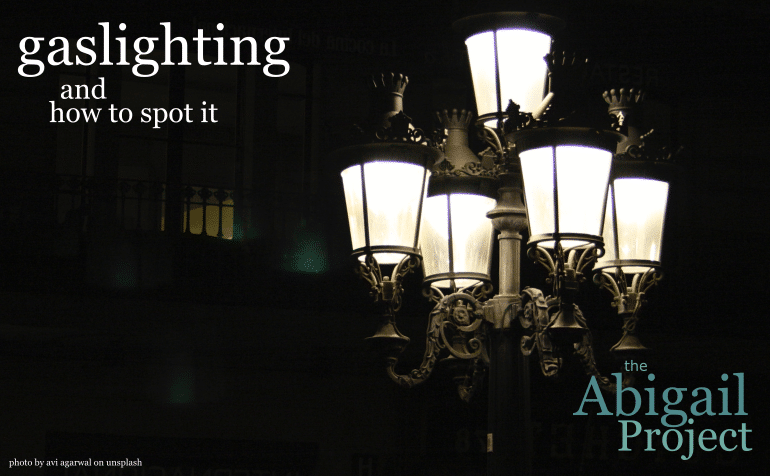What is gaslighting?
Gaslighting is a commonly used term these days, but what does it mean? How can you tell if it’s happening to you or to someone you know? Let’s take a 2-minute look.
Definition
The American Psychological Association defines gaslight as:
To manipulate another person into doubting his or her perceptions, experiences, or understanding of events.1
They note that:
The term once referred to manipulation so extreme as to induce mental illness or to justify commitment of the gaslighted person to a psychiatric institution but is now used more generally.2
The Gaslight story
You may already know that the term, “gaslighting”, comes from a reference to a movie, Gaslight.3 In the 1944 remake, Gregory married Paula so he could find her famous aunt’s lost jewels. While secretly searching their attic, Gregory turned the gaslights on, which dimmed the lights downstairs.
When Paula commented on the dimming lights, Gregory denied it was happening. He used that opportunity to try and drive Paula crazy, hoping to get her institutionalised, leaving him free to keep searching.
Likewise, when Paula heard his footsteps, Gregory convinced her she was hearing things. He stole things and placed them in her handbag to convince her she was a kleptomaniac.
Paula’s memories of events were accurate.
She had seen and heard the evidence herself. But Gregory denied it so convincingly that she doubted herself. Gregory effectively inserted himself as her source of truth.
That’s gaslighting.
What does gaslighting look like?
One of Gregory’s tactics in the movie was to convince Paula she had a bad memory. He would say things like,
You’re so forgetful!
You know you’re always forgetting things!
But Paula’s memory was fine. She remembered real events but Gregory tried to convince her otherwise.
There’s a joke circling the internet that goes:
I’ve got a joke about gaslighting
You’ve got a joke about gaslighting?
I never said that!
Gaslighting is a type of lying where both of you know the truth, but one is convincingly denying it.
Abusers love to create self-doubt. It’s a powerful tool in the hands of an abuser. If they can effectively deny the reality of their behaviour or its impact, they can keep control of their victims.
Gaslighting in the Bible
One example of gaslighting in the Bible is in the story of Saul and Samuel. There was a moment when Samuel gave King Saul instructions from God: Saul was to destroy the Amalekites.
Then Samuel said to Saul, “The LORD sent me to anoint you king over His people Israel. Now therefore, listen to the words of the LORD. This is what the LORD of Hosts says:
‘I witnessed what the Amalekites did to the Israelites when they ambushed them on their way up from Egypt. Now go and attack the Amalekites and devote to destruction all that belongs to them. Do not spare them, but put to death men and women, children and infants, oxen and sheep, camels and donkeys.’ ”4
Both Samuel and Saul knew what the instructions were. When Samuel challenged Saul for not following them, Saul sounded surprised:
“But I did obey the LORD”, he claimed5
Then he went on to change what God had said.
Saul and Samuel knew the truth, but Saul tried to change Samuel’s memory of it. That’s gaslighting. (You can read more about that story here.)
Gaslighting is a powerful tactic and with constant pressure an abusive person can use it to decimate and control their victims.
Some quick tips to finish
Gaslighting is unlikely to be the only abusive tactic a person uses. Even in the movie, Gregory controlled Paula with love-bombing, physical aggression, humiliation, and isolation.
If you suspect you might be the victim of gaslighting, talking to a therapist or contacting a helpline like 1800RESPECT could be of great benefit.
Finding trustworthy sources of truth can also help fight self-doubt. Paula had two people who cared, and that saved her.





0 Comments